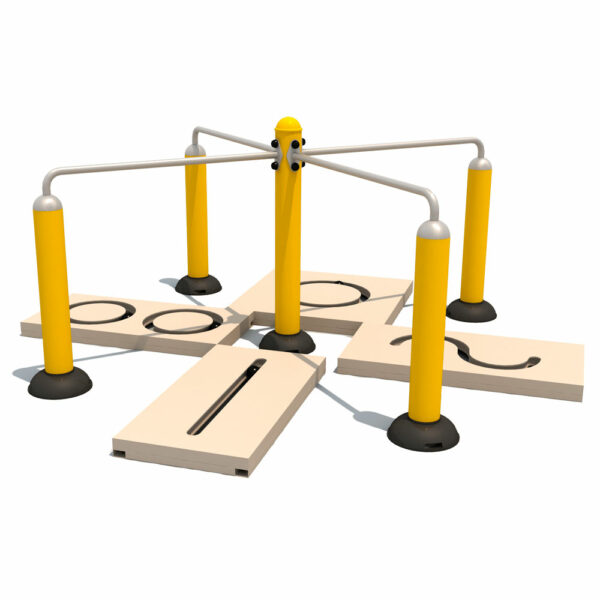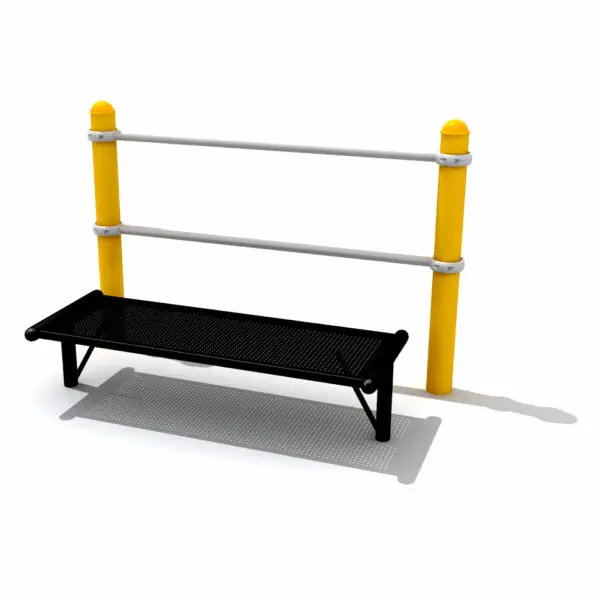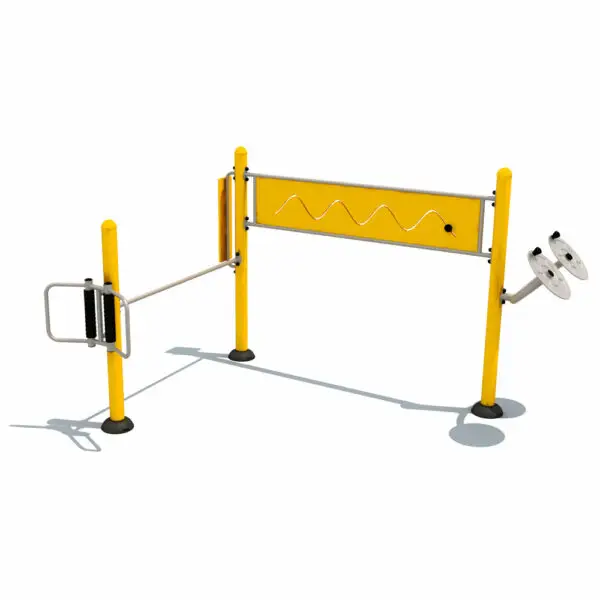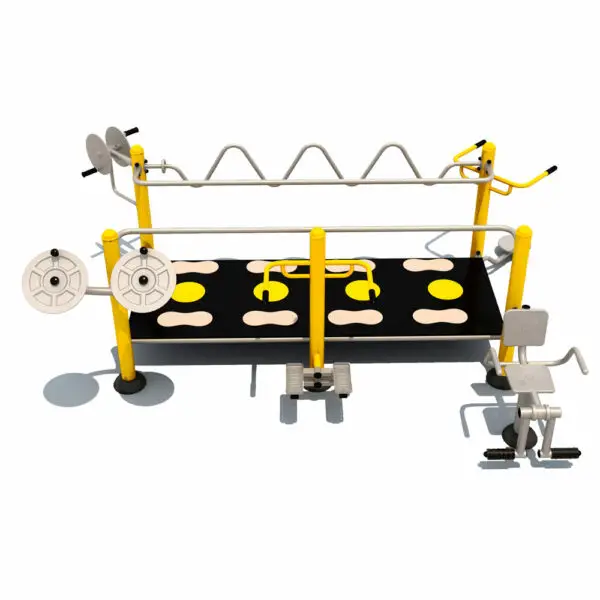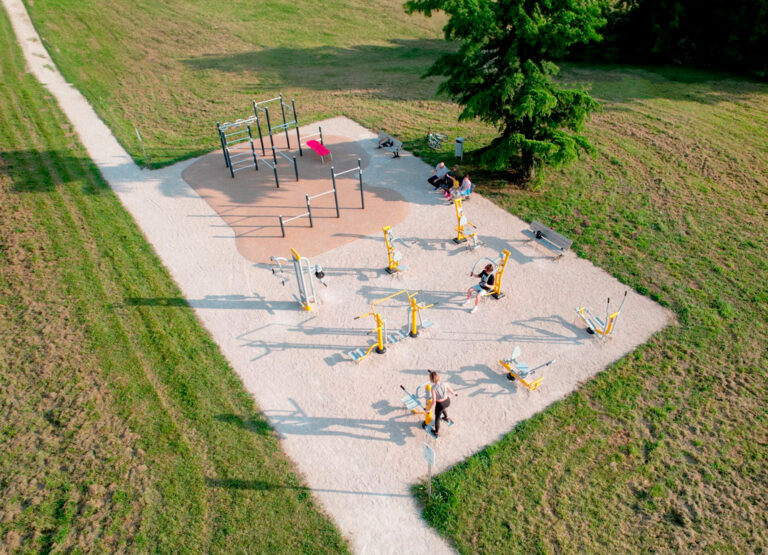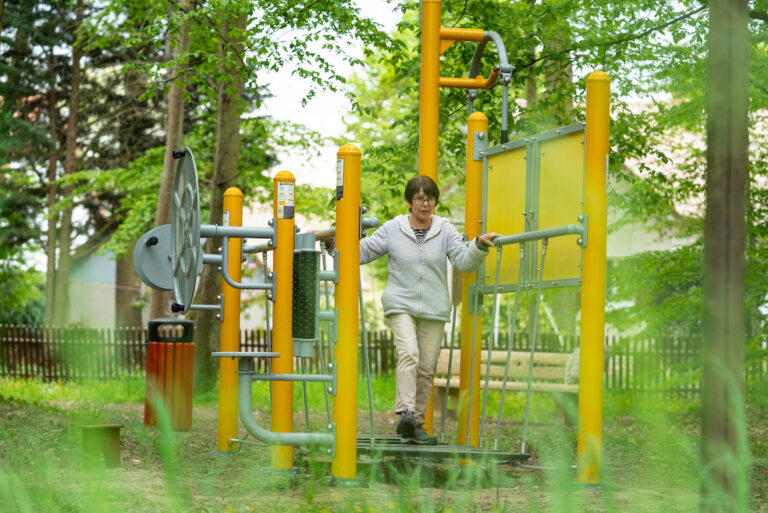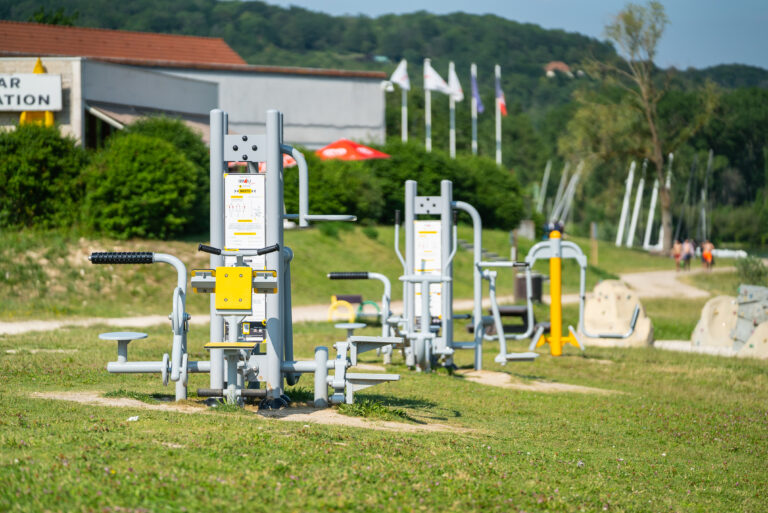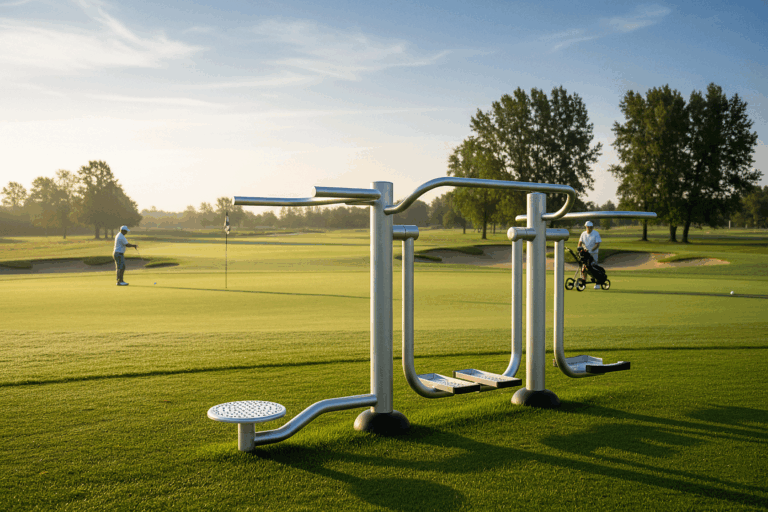Introduction
Physical activity is essential to everyone’s general well-being and health. However, access to suitable sports facilities remains a challenge for many people, especially seniors and people with reduced mobility (PRM). Outdoor fitness, with its open-air facilities, offers a unique opportunity to promote physical activity accessible to all. Yet, without inclusive design, these spaces can inadvertently exclude those who would benefit most.
Why should outdoor fitness be inclusive?
Inclusive design ensures that everyone, regardless of their physical abilities, can take part in outdoor physical activities. This promotes not only physical health, but also mental and social well-being. Inclusive outdoor fitness spaces encourage social interaction, reduce isolation and strengthen the sense of community.
Challenges for local authorities and sports equipment manufacturers
Communities have a responsibility to create accessible environments that meet the needs of all their citizens. Sports equipment manufacturers, for their part, play a crucial role in designing adapted and safe facilities. By working together, these players can transform public spaces into welcoming places, encouraging physical activity for all, and thus contributing to a healthier, more inclusive society.
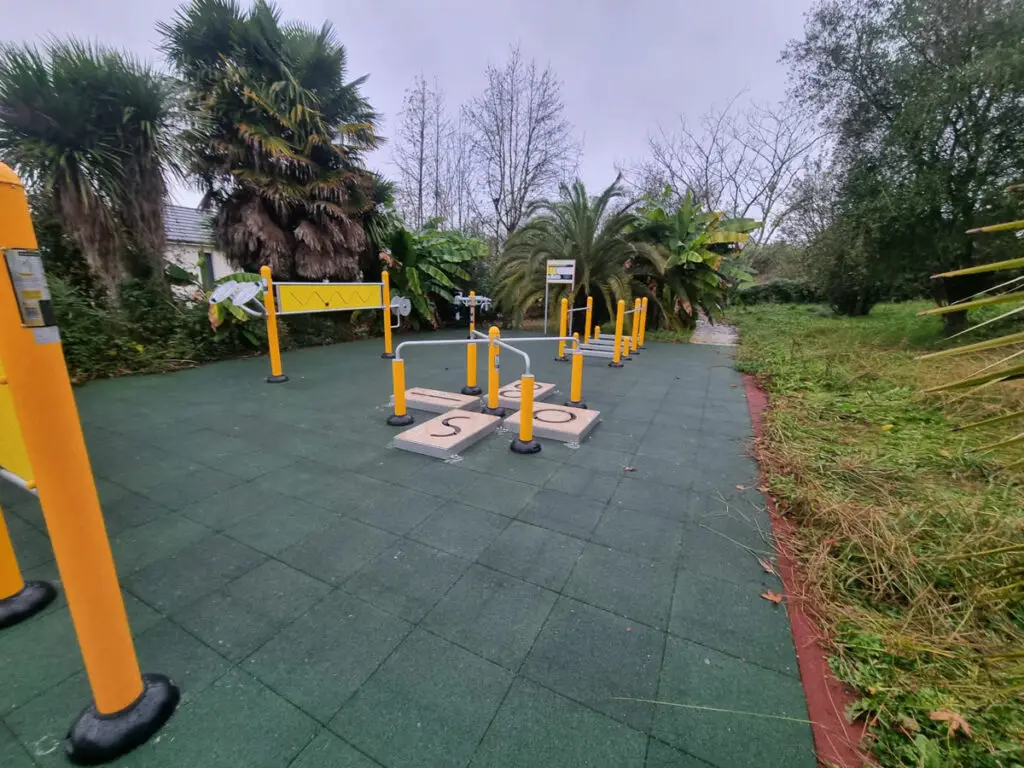
Why is accessibility essential in outdoor sports?
Outdoor fitness is a great opportunity to promote physical activity to all publics. However, without thoughtful, accessible design, these facilities can inadvertently exclude thousands of people who could benefit from them. Seniors, people with disabilities or even beginners: everyone needs to be able to find their place and practice independently.
By integrating accessibility into the design of outdoor fitness areas, we promote a more inclusive, dynamic and healthier society.
Sport for all: a fundamental right
Sport: a lever for social inclusion and well-being
Physical activity is not just a question of physical fitness: it’s also a key factor in mental and social well-being. Studies show that exercise reduces stress, improves mood and encourages social interaction.
But for sport to benefit everyone, it has to be accessible. Yet many sports facilities are not designed to meet the needs of people with disabilities, senior citizens or even beginners who lack confidence.
Unequal access to sports facilities
According to a WHO study, 35% of adults are not sufficiently physically active, a figure that rises to 70% among people with disabilities. Among the main causes are :
- Lack of adapted facilities in parks and public spaces.
- Lack of information on accessible infrastructures.
- Lack of support for people who need initiation or follow-up.
💡 If these obstacles were removed, outdoor sports could explode and benefit society as a whole!
Barriers to outdoor fitness for certain populations
Accessibility for the disabled still too limited
Despite laws on accessibility, many sports facilities remain unsuitable for PRMs (People with Reduced Mobility) and people with special needs.
Common problems encountered :
- Difficult or non-existent access 🛑
- Lack of access ramps and stabilized paths (gravel and uneven ground prevent wheelchair access).
- Equipment too high or requiring the use of both legs.
- Lack of suitable equipment 💪
- Few machines are wheelchair-accessible.
- No ergonomic handles for people with motor impairments.
- No specific signal 📍
- Explanatory panels in text only, without Braille or audio versions.
- Absence of QR codes giving access to adapted demonstrations.
Seniors and people with reduced mobility: specific needs ignored
As we age, physical activity becomes essential to maintain mobility and avoid loss of independence. Yet many seniors are reluctant to use outdoor fitness equipment because of :
- Lack of handles and stable supports for safe exercise.
- Ill-adapted exercises, often too intense or requiring considerable muscular strength.
- Unsuitable floor coverings, increasing the risk of falls.
💡 Equipment specifically designed for seniors (like those in the Sénior/PMR range from Herkules Fitness) can encourage their safe practice.
Beginners and overweight people: a lack of support
For someone new to sport or overweight, outdoor fitness can seem daunting. Among the most common difficulties:
- Lack of explanation of how to use the equipment.
- Fear of other people’s gaze in a public space.
- Demanding equipment that doesn’t take into account users’ varying capabilities.
💡 Adding clear instructions and offering scalable exercises can remove these barriers and encourage more people to practice.
The positive impact of accessibility on society
Investing in the accessibility of outdoor fitness areas not only benefits those directly concerned. It’s a move that has far-reaching positive effects on society as a whole.
Improving public health
- Regular physical activity can reduce the risk of cardiovascular disease by 30%.
- Easier access to sport helps prevent obesity, particularly among young people and seniors.
- Physical activity helps preserve motor skills, delaying age-related dependency.
Strengthening social ties and reducing inequalities
- An inclusive fitness park becomes a meeting place for people of all generations and physical conditions.
- These facilities promote the autonomy of PRMs and enable them to practice a sport without having to rely on medical supervision.
- They encourage social diversity, by integrating people with disabilities and senior citizens into spaces shared with the rest of the population.
Enhancing public spaces and making cities more attractive
- A city that invests in accessible facilities improves its image and attractiveness to tourists.
- These developments encourage greater use of public spaces, making parks and urban areas more lively.
- Success stories from abroad show that these projects generate positive economic spin-offs by attracting new residents and visitors.
💡 A good inclusive layout can transform a simple sports space into a real place for living and sharing!
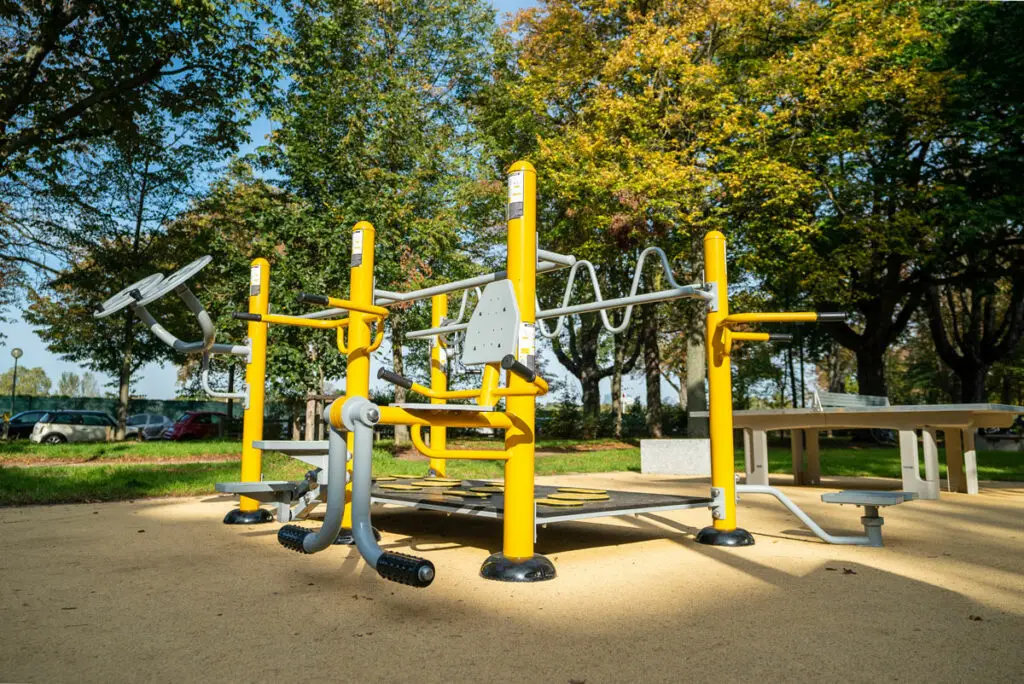
How do you design an inclusive outdoor fitness area?
Creating an inclusive outdoor fitness space requires more than just adding a few accessible pieces of equipment. It requires a holistic approach that takes into account ergonomics, accessibility, exercise diversity and the overall environment. In this section, we’ll explore the key principles for designing a truly inclusive sports park.
Essential criteria for an accessible layout
1. Physical accessibility: facilitating access for all users
For an outdoor fitness area to be truly inclusive, it must be accessible right from the entrance. All too often, simple obstacles such as stairs, narrow paths or unstable surfaces make access impossible for PRMs or senior citizens.
💡 Solutions to integrate :
- Access ramps to PMR standards with an adapted slope.
- Wide, stabilized paths (avoid gravel or muddy surfaces).
- Entrances and passageways large enough to accommodate a wheelchair.
- Non-slip surfaces, even in the rain.
2. Space organization: a logical, fluid layout
A good layout ensures smooth circulation and intuitive use of equipment. Avoid compact areas where users can get in each other’s way.
💡 Best practices :
- Space out equipment to avoid overcrowding.
- Include rest areas with benches close to the equipment.
- Create several adapted sports circuits (e.g. a circuit for beginners, a circuit for PRMs, a dynamic circuit for the more advanced).
- Ensure good visibility of equipment to prevent certain facilities from going unused.
3. Materials and safety: guaranteeing risk-free use
A fitness area must be durable and safe for all users, especially those with special needs.
💡 Recommended materials:
✔️ Soft coverings to limit impact in the event of a fall.
✔️ Ergonomic handles and non-slip coverings on equipment.
✔️ Weather-resistant materials, preventing rapid deterioration (galvanized steel, aluminum, treated wood).
✔️ Absence of sharp angles or cutting surfaces on equipment.
Adapting outdoor fitness equipment
An inclusive space must offer a variety of equipment enabling everyone to train according to their abilities. Conventional street workout or weight training equipment is often not suitable for PRMs or people with physical limitations.
💡 Essential features of accessible equipment:
✔️ Adjustable height of bars and apparatus to enable wheelchair use.
✔️ Equipment with adjustable resistance, suitable for beginners and experienced athletes alike.
✔️ Stable seats or supports for people who have difficulty standing for long periods.
✔️ Thick, ergonomic handles for easy handling.
✔️ Equipment can be used with only one hand, for people with reduced mobility on one side of the body.
Examples of equipment adapted to different audiences:
For wheelchair users:
- Arm trainer to develop the upper body.
- Stretch traction with adjustable height.
For seniors and people with reduced mobility:
- Low-impact equipment(elliptical trainer, rowing machine).
- Espaliers for safe balance training.
For beginners and overweight people:
- Progressive resistance exercises to avoid injury.
- Machines providing good back and joint support.
- Warm-up and stretching areas.
💡 The Senior/PMR range from Herkules Fitness incorporates these criteria and enables local authorities to set up suitable facilities.
Landscape integration and user comfort
An inclusive outdoor fitness area must also be pleasant to use. The choice of surroundings, shaded areas and street furniture plays a key role in the user experience.
💡 Elements to consider:
✔️ Landscaping integration to make the space visually attractive.
✔️ Presence of shaded areas to prevent heat stroke in summer.
✔️ Rest areas with benches and water fountains.
✔️ Toilets accessible to PRMs nearby.
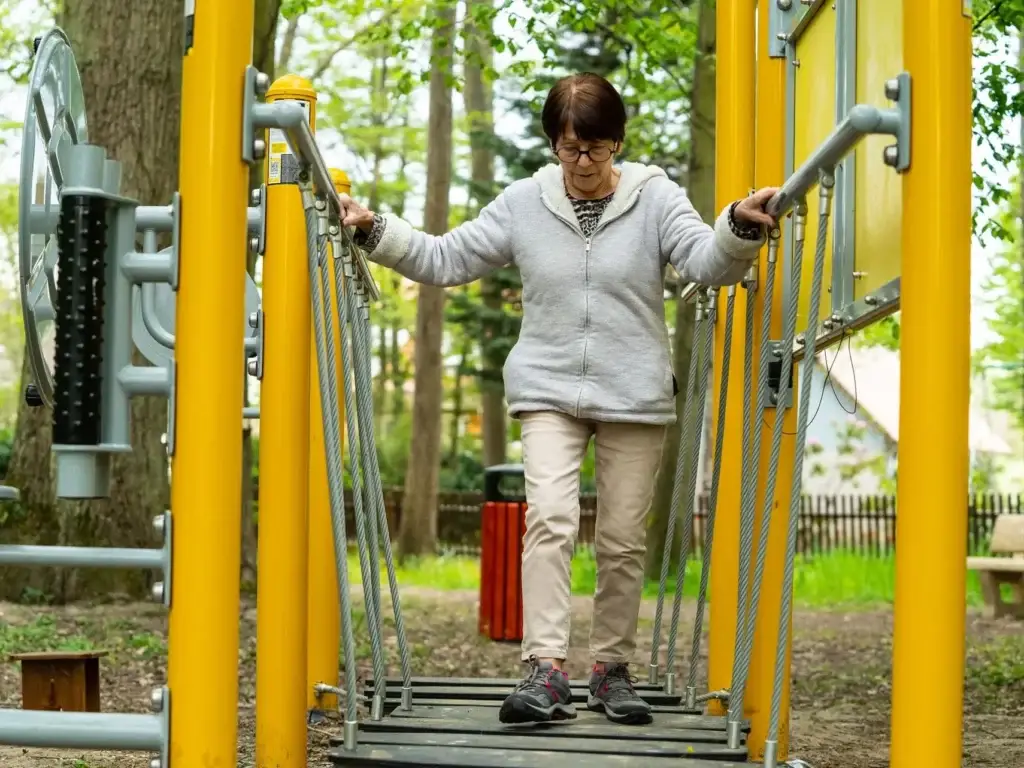
Examples of best practices and committed cities
Many towns and cities are now realizing the importance of inclusive outdoor fitness and are setting up suitable facilities. These initiatives show that it is possible to create sports areas that are accessible to all, while improving urban attractiveness and citizens’ well-being.
In this section, we’ll look at concrete examples, testimonials and case studies that illustrate best practice in inclusive sports planning.
Case studies in France and Europe
🇫🇷 Paris: an evolving model
The city of Paris has launched several inclusive outdoor fitness projects as part of its “Paris Sport Accessible” plan.
🔹 Actions implemented :
✔️ Installation of inclusive sports trails in several parks, with equipment adapted for PRMs and seniors.
✔️ Creation of accessible street workout areas, with adjustable bars and wheelchair-accessible machines, such as in Tolstoi Square.
💬 User testimonial:
“Before, I had to go to the gym, which was complicated with my wheelchair. Now I can work out outdoors, at my own pace. It’s a real step forward!” – Julien, 32, user of a PMR space in Paris.
🇩🇰 Copenhagen: a leader in urban inclusion
The Danish capital is often cited as a model of inclusive urban planning.
🔹 S pecial features of sports facilities in Copenhagen :
✔️ Multi-sport areas accessible to all, with running tracks adapted for PRMs.
✔️ Street furniture designed for inclusion, including benches with armrests and soft flooring.
✔️ Inclusive outdoor fitness machines, with adjustable resistance systems that can be used by all.
✔️ Innovative, aesthetic design, to avoid the “medical infrastructure” effect.
💡 The success of these initiatives has encouraged other European cities to follow suit.
Barcelona: a strong commitment to outdoor sport
Barcelona has developed a network of outdoor sports areas to encourage the practice of sport for all, with an emphasis on inclusivity.
🔹 Main initiatives :
✔️ Creation of over 80 outdoor fitness areas, some of which are 100% accessible to PRMs.
✔️ Training courses for sports coaches, to support people with disabilities.
✔️ Partnerships with specialized associations to ensure that equipment meets the real needs of users.
Testimonials from users and experts
The impact of inclusive outdoor fitness is measured not just in terms of the number of pieces of equipment installed, but also through the experience of users and sports professionals.
🏋️ Testimonial from a sports coach specializing in accessibility :
“I run sports sessions for seniors and wheelchair users. What changes everything is having equipment where everyone can train together. It’s a real step forward!” – Sophie, health sports coach
♿ PMR user testimonial:
“I thought outdoor fitness equipment wasn’t for me. When I discovered an accessible space in my town, it changed my relationship with sport. Now, I come to train every week!” – Lucas, 45, paraplegic
Herkules Fitness’ commitment to accessible outdoor sport
At Herkules Fitness, we firmly believe that sport should be accessible to all, regardless of age or physical condition. That’s why we’ve developed a specific range of equipment for seniors and people with reduced mobility (PRM), enabling everyone to enjoy physical activity in complete safety and autonomy.
In this section, we will detail our solutions and commitments to local authorities and businesses wishing to create an inclusive outdoor fitness area.
Our solutions to make outdoor fitness inclusive
💡 A complete range for seniors and PRMs
Herkules Fitness offers a wide range of equipment specially designed to meet the needs of people with physical limitations.
🔹 Key features of our inclusive equipment:
✔️ Adjustable height to enable wheelchair use.
✔️ Modular resistance equipment, to suit different fitness levels.
✔️ Ergonomic seats and supports to ensure stability and safety.
✔️ Thick, non-slip handles for a better grip.
✔️ Intuitive operation, with explanatory panels and QR codes leading to demonstration videos.
🔗 S ee our complete Senior/PMR range here ➡️ Herkules Fitness – Sport Santé, Senior & PMR
Examples of inclusive equipment offered by Herkules Fitness
Le Moulinet – Wheelchair accessible
✔️ Strengthens the upper body and improves coordination.
✔️ Easy access and suitable for PRM.
Sitting upright – Perfect for seniors
✔️ Helps improve mobility and posture.
✔️ Supports rehabilitation and gentle strengthening work.
Pull-For the right workout
✔️ Can be used in a wheelchair or standing up.
This equipment has been designed in collaboration with experts in the field of sport and accessibility, to ensure safe and effective use for all users.
🎯 Conclusion
Making outdoor fitness accessible to all is a major challenge for promoting inclusion, health and well-being. By integrating equipment adapted for seniors and people with reduced mobility, local authorities and businesses can create truly inclusive sports areas.
At Herkules Fitness, we offer practical solutions to meet these needs. Would you like to create an accessible outdoor fitness area?
📩 Contact us today for personalized support and a customized quote!
➡️ Request a quote

